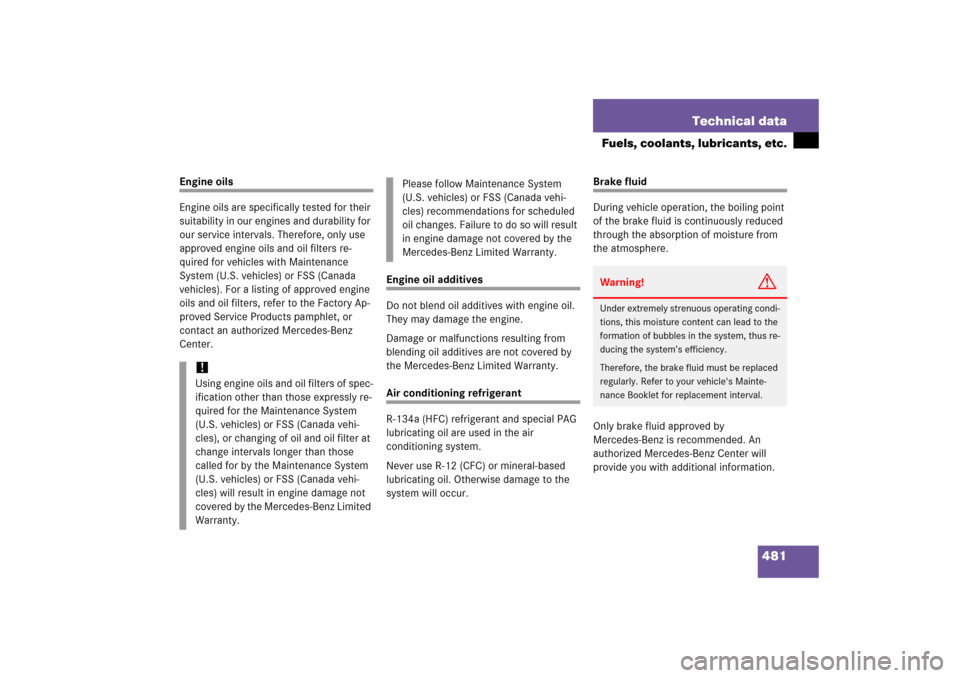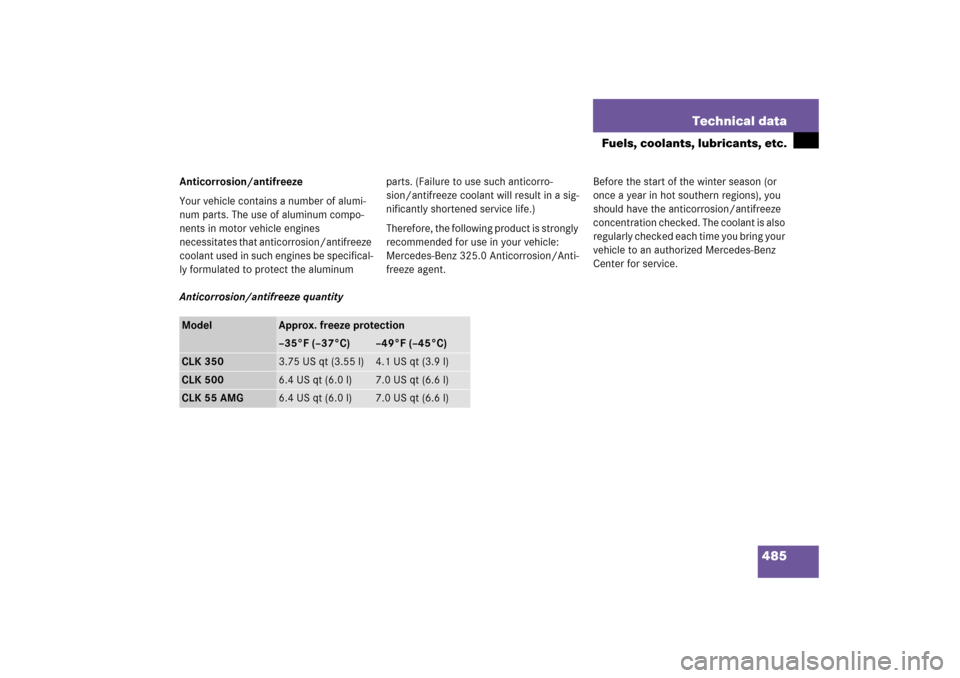Page 466 of 514
465 Technical data
Parts service
Warranty coverage
Identification labels
Layout of poly-V-belt drive
Engine
Rims and tires
Electrical system
Main dimensions and weights
Fuels, coolants, lubricants, etc.
Page 467 of 514
466 Technical dataThe “Technical data” section provides the
necessary technical data for your vehicle.Parts service
All authorized Mercedes-Benz Centers
maintain a stock of Genuine
Mercedes-Benz parts required for mainte-
nance and repair work. In addition, strate-
gically located parts distribution centers
provide quick and reliable parts service.
More than 300 000 different parts for
Mercedes-Benz models are available.
Genuine Mercedes-Benz parts are subject-
ed to stringent quality inspections. Each
part has been specifically developed, man-
ufactured or selected for and adapted to
Mercedes-Benz vehicles.
Therefore, Genuine Mercedes-Benz parts
should be installed.
!The use of non-genuine Mercedes-Benz
parts and accessories not authorized
by Mercedes-Benz could damage the
vehicle, which is not covered by the
Mercedes-Benz Limited Warranty, or
could compromise the vehicle’s dura-
bility or safety.
Page 468 of 514
467 Technical data
Warranty coverage
�Warranty coverage
Your vehicle is covered under the terms of
the warranties printed in the Service and
Warranty Information booklet. Your autho-
rized Mercedes-Benz Center will exchange
or repair any defective parts originally in-
stalled in the vehicle in accordance with
the terms of the following warranties:�
New Vehicle Limited Warranty
�
Emission System Warranty
�
Emission Performance Warranty
�
California, Maine, Massachusetts, and
Vermont Emission Control Systems
WarrantyReplacement parts and accessories are
covered by the Mercedes-Benz Parts and
Accessories warranties, copies of which
are available at any Mercedes-Benz
Center.Loss of Service and Warranty
Information Booklet
Should you lose your Service and Warranty
Information booklet, have an authorized
Mercedes-Benz Center arrange for a
replacement. It will be mailed to you.
Page 482 of 514

481 Technical data
Fuels, coolants, lubricants, etc.
Engine oils
Engine oils are specifically tested for their
suitability in our engines and durability for
our service intervals. Therefore, only use
approved engine oils and oil filters re-
quired for vehicles with Maintenance
System (U.S. vehicles) or FSS (Canada
vehicles). For a listing of approved engine
oils and oil filters, refer to the Factory Ap-
proved Service Products pamphlet, or
contact an authorized Mercedes-Benz
Center.
Engine oil additives
Do not blend oil additives with engine oil.
They may damage the engine.
Damage or malfunctions resulting from
blending oil additives are not covered by
the Mercedes-Benz Limited Warranty.Air conditioning refrigerant
R-134a (HFC) refrigerant and special PAG
lubricating oil are used in the air
conditioning system.
Never use R-12 (CFC) or mineral-based
lubricating oil. Otherwise damage to the
system will occur.
Brake fluid
During vehicle operation, the boiling point
of the brake fluid is continuously reduced
through the absorption of moisture from
the atmosphere.
Only brake fluid approved by
Mercedes-Benz is recommended. An
authorized Mercedes-Benz Center will
provide you with additional information.
!Using engine oils and oil filters of spec-
ification other than those expressly re-
quired for the Maintenance System
(U.S. vehicles) or FSS (Canada vehi-
cles), or changing of oil and oil filter at
change intervals longer than those
called for by the Maintenance System
(U.S. vehicles) or FSS (Canada vehi-
cles) will result in engine damage not
covered by the Mercedes-Benz Limited
Warranty.
Please follow Maintenance System
(U.S. vehicles) or FSS (Canada vehi-
cles) recommendations for scheduled
oil changes. Failure to do so will result
in engine damage not covered by the
Mercedes-Benz Limited Warranty.
Warning!
G
Under extremely strenuous operating condi-
tions, this moisture content can lead to the
formation of bubbles in the system, thus re-
ducing the system’s efficiency.
Therefore, the brake fluid must be replaced
regularly. Refer to your vehicle's Mainte-
nance Booklet for replacement interval.
Page 484 of 514

483 Technical data
Fuels, coolants, lubricants, etc.
Gasoline additives
A major concern among engine manufac-
turers is carbon build-up caused by gaso-
line. Mercedes-Benz recommends only the
use of quality gasoline containing additives
that prevent the build-up of carbon depos-
its.
After an extended period of using fuels
without such additives, carbon deposits
can build up especially on the intake valves
and in the combustion area, leading to en-
gine performance problems such as:�
Warm-up hesitation
�
Unstable idle
�
Knocking/pinging
�
Misfire
�
Power lossIn areas where carbon deposits may be en-
countered due to lack of availability of gas-
olines which contain these additives,
Mercedes-Benz recommends the use of
additives approved by us for use on
Mercedes-Benz vehicles. Refer to Factory
Approved Service Products pamphlet for a
listing of approved product(s). Follow di-
rections on product label.
Do not blend other fuel additives with fuel.
This only results in unnecessary cost and
may be harmful to the engine operation.Damage or malfunction resulting from
poor fuel quality or from blending addition-
al fuel additives other than those tested
and approved by us for use on
Mercedes-Benz vehicles listed in the
Factory Approved Service Products pam-
phlet are not covered by the
Mercedes-Benz Limited Warranty.
Page 485 of 514

484 Technical dataFuels, coolants, lubricants, etc.Coolants
The engine coolant is a mixture of water
and anticorrosion / antifreeze, which
provides:�
Corrosion protection
�
Freeze protection
�
Boiling protection (by increasing the
boiling point)
The cooling system was filled at the factory
with a coolant providing freeze protection
to approximately -22°F (-30°C) and
corrosion protection.
If the antifreeze mixture is effective
to -22°F (-30°C), the boiling point of the
coolant in the pressurized cooling system
is reached at approx. 266°F (130°C).The coolant solution must be used
year-round to provide the necessary corro-
sion protection and increase boil-over pro-
tection. Refer to Maintenance Booklet for
replacement interval.
Coolant system design and coolant used
determine the replacement interval. The
replacement interval published in the
Maintenance Booklet is only applicable if
MB 325.0 Anticorrosion/Antifreeze solu-
tion or other Mercedes-Benz approved
products of equal specification (see Facto-
ry Approved Service Products pamphlet)
are used to renew the coolant concentra-
tion or bring it back up to the proper level.To provide important corrosion protection,
the solution must be at least 45% anticor-
rosion/antifreeze (equivalent to freeze
protection to approx. -22°F [-30°C]). If you
use a solution that is more than 55% anti-
corrosion/antifreeze (freeze protection to
approx. -49°F [-45°C]), the engine temper-
ature will increase due to the lower heat
transfer capability of the solution. There-
fore, do not use more than this amount of
anticorrosion/antifreeze.
If the coolant level is low, water and MB
Anticorrosion /Antifreeze should be used
to bring it up to the proper level (have cool-
ing system checked for signs of leakage).
Please make sure the mixture is in accor-
dance with label instructions.
The water in the cooling system must meet
minimum requirements, which are usually
satisfied by normal drinking water. If you
are not sure about the water quality,
consult an authorized Mercedes-Benz
Center.
Page 486 of 514

485 Technical data
Fuels, coolants, lubricants, etc.
Anticorrosion/antifreeze
Your vehicle contains a number of alumi-
num parts. The use of aluminum compo-
nents in motor vehicle engines
necessitates that anticorrosion/antifreeze
coolant used in such engines be specifical-
ly formulated to protect the aluminum parts. (Failure to use such anticorro-
sion/antifreeze coolant will result in a sig-
nificantly shortened service life.)
Therefore, the following product is strongly
recommended for use in your vehicle:
Mercedes-Benz 325.0 Anticorrosion/Anti-
freeze agent.Before the start of the winter season (or
once a year in hot southern regions), you
should have the anticorrosion/antifreeze
concentration checked. The coolant is also
regularly checked each time you bring your
vehicle to an authorized Mercedes-Benz
Center for service.
Anticorrosion/antifreeze quantityModel
Approx. freeze protection–35°F (–37°C)
–49°F (–45°C)
CLK 350
3.75 US qt (3.55 l)
4.1 US qt (3.9 l)
CLK 500
6.4 US qt (6.0 l)
7.0 US qt (6.6 l)
CLK 55 AMG
6.4 US qt (6.0 l)
7.0 US qt (6.6 l)
Page 488 of 514

487 Technical terms
ABS
(A
ntilock B
rake S
ystem)
Prevents the wheels from locking up
during braking so that the vehicle can
continue to be steered.
Accessory weight
(
�page 355)
Air pressure
(�page 355)
Alignment bolt
Metal pin with thread. The centering
pin is an aid used when changing a tire
to align the wheel with the wheel hub.
Aspect ratio
(�page 355)
Bar
(�page 355)
BAS
(Brake A
ssist S
ystem)
System for potentially reducing braking
distances in emergency braking situa-
tions. The system is activated when it
senses an emergency based on how
fast the brake is applied.Bead
(
�page 355)
Bi-Xenon headlamps*
Headlamps which use an electric arc as
the light source and produce a more in-
tense light than filament headlamps.
Bi-Xenon headlamps produce low
beam and high beam.
CAC
(Customer A
ssistance C
enter)
Mercedes-Benz customer service cen-
ter, which can help you with any ques-
tions about your vehicle and provide
assistance in the event of a break-
down.
CAN system
(C
ontroller A
rea N
etwork)
Data bus network serving to control ve-
hicle functions such as door locking or
windshield wiping.Cockpit
All instruments, switches, buttons and
indicator/warning lamps in the passen-
ger compartment needed for vehicle
operation and monitoring.
Cold tire inflation pressure
(
�page 355)
COMAND
(Cockpit M
anagement and D
ata Sys-
tem)
Information and operating center for
vehicle sound and communications
systems, including the radio and the
navigation system, as well as other op-
tional equipment (CD changer*, tele-
phone, etc.).
Control system
The control system is used to call up
vehicle information and to change
component settings. Information and
messages appear in the multifunction
display. The driver uses the buttons on
the multifunction steering wheel to
navigate through the system and to ad-
just settings.